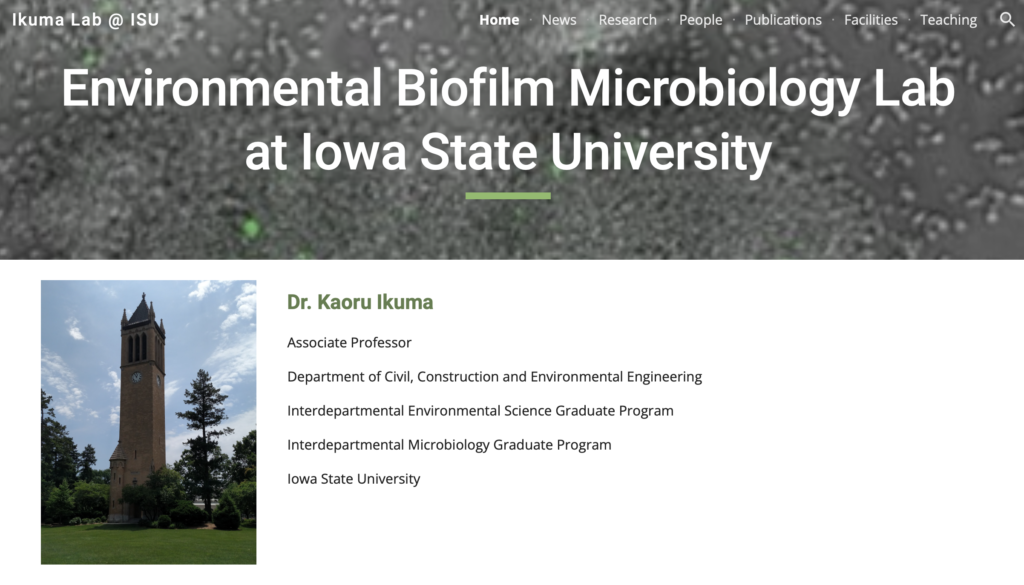
Dr. Kaoru Ikuma

Meet Dr. Kaoru Ikuma, an accomplished Associate Professor and Cerwick Faculty Fellow at Iowa State University. Her research endeavors center around environmental microbiology and biotechnology, with a particular focus on biodegradation of hazardous contaminants and sustainable water and wastewater treatment. Beyond her scientific pursuits, Kaoru is a strong advocate for water security and environmental justice, seeking to make a positive impact in the realm of environmental biofilm microbiology.
Education
- Ph.D. Civil and Environmental Engineering, Duke University, 2011
- M.S. Environmental Sciences and Engineering, Virginia Polytechnic Institute and State University, 2007
- B.S. Biochemistry, Virginia Polytechnic Institute and State University, 2005
- B.S. Biology, Virginia Polytechnic Institute and State University, 2005
Email: kikuma@iastate.edu
Publication
- Exploring Water Justice, Equity, and Security: Current Federally-Funded Projects
- Croll H.C.*, Ikuma K., Ong S.K., Sarkar S. Systematic performance evaluation of reinforcement learning algorithms applied to wastewater treatment control optimization. Environmental Science & Technology 2023, in press.
- Croll H.*, Ikuma K., Sarkar S., Ong S.K. Reinforcement learning applied to wastewater treatment process control optimization: Approaches, challenges, and path forward. Critical Reviews in Environmental Science and Technology 2023. [doi.org/10.1080/10643389.2023.2183699]
- Brown P.*, Ikuma K., Ong S. K. Biological phosphorus removal and its microbial community in a modified full-scale activated sludge system under dry and wet weather dynamics. Water Research 2022, 216: 118338. [doi.org/10.1016/j.watres.2022.118338]
- Spellman C. D., Daer S.*, Ikuma K., Silverman I., Goodwill J. E. Sulfite-activated ferrate for water reuse applications. Water Research 2022, 216: 118317. [doi:10.1016/j.waterres.2022.118317]
- Daer S.*, Rehmann E., Rehmann J., Ikuma K. Development of resistance in Escherichia coli against repeated disinfection: Implications for water reuse. Frontiers in Environmental Science 2022, 14 March 2022. [doi:10.3389/fenvs.2022.855224]
- Pinto-Vilar R.*, Ikuma K. Effects of soil surface chemistry in adsorption and activity of urease in a crude protein extract and its implications to biocementation applications. Catalysts 2022, 12(2): 230. [doi:10.3390/catal12020230]
- Pinto-Vilar R.*, Ikuma K. Adsorption of urease as part of a complex protein mixture onto soil and its implications to enzymatic activity. Biochemical Engineering Journal 2021, 171: 108026. [10.1016/j.bej.2021.108026]
- Daer S.*, Goodwill J. E., Ikuma K. Effect of ferrate and hypochlorite disinfection on the physiological and transcriptomic response of Escherichia coli. Water Research 2021, 189: 116580. [doi:10.1016/j.waterres.2020.116580]
- Kralles Z. T., Ikuma K., Dai N. Assessing disinfection byproduct risks for algal impacted surface waters and the effects of peracetic acid pre-oxidation. Environmental Science: Water Research & Technology 2020, 6: 2365. [doi:10.1039/d0ew00237b]
- Lee J., Choi J., Fatka M., Swanner E., Ikuma K., Liang X.*, Leung T., Howe A. Improved detection of mcyA genes and their phylogenetic origins in harmful algal blooms. Water Research 2020, 176: 115730. [doi:10.1016/j.waterres.2020.115730]
- Tan Y., Park J., Ikuma K., Evans E. A., Flamming J. J., Ellis T. G. Feasibility test of autotrophic denitrification of industrial wastewater in sequencing batch and static granular bed reactors. Water Environment Research 2020, 92: 749-758. [doi:10.1002/wer.1271] (accepted in 2019)
- Ikuma K. and Rehmann C.R. Importance of extracellular DNA in the fate and transport of antibiotic resistance genes downstream of a wastewater treatment plant. Environmental Engineering Science 2020, 37 (2): 164-168. [doi:10.1089/ees.2019.0319] (accepted in 2019)
- Hoang T., Alleman J., Cetin B., Ikuma K., Choi S. G. Sand and silty-sand soil stabilization using bacterial enzyme induced calcite precipitation (BEICP). Canadian Geotechnical Journal 2019, 56 (6): 808-822. [doi:10.1139/cgj-2018-0191]
- Pruden A., Alcalde R. E., Alvarez P. J., Ashbolt N. J., Biscel H., Capiro N. L., Crossette E., Frigon D., Grimes K., Haas C. N., Ikuma K., Kappell A., LaPara T., Lee K., Li M., Li X., McNamara P., Seo Y., Sobsey M., Sozzi E., Navab-Daneshmand T., Nguyen T. H., Raskin L., Prieto Riquelme M. V., Vikesland P., Wigginton K., Zhou Z. Towards an environmental science and engineering framework for monitoring and mitigating antimicrobial resistance. Environmental Engineering Science 2018, 35 (10):1005-1011. [doi:10.1089/ees.2017.0520]
- Sturgeon S. R., Pilsner R., Arcaro K. F., Ikuma K., Wu H., Kim S. M., Chopra-Tandon N., Karpf A., Ziegler R. G., Schairer C., Balasubramanian R., Reckhow D. A. White blood cell DNA methylation and risk of breast cancer in the prostate, lung, colorectal, and ovarian cancer screening trial (PLCO). Breast Cancer Research 2017, 19: 94. [doi:10.1186/s13058-017-0886-6]
- Schwartz G. E., Redfern L. K., Ikuma K., Gunsch C. K., Ruhl L. S., Vengosh A., Hsu-Kim H. Impacts of coal ash on microbial methyl mercury production and the methylating microbial community in anaerobic sediment slurries. Environmental Science: Processes & Impacts 2016, 18: 1427-1439. [doi:10.1039/c6em00458j]
- Ikuma K., Shi Z., Walker A. V., Lau B. L. T. Effects of protein species and surface physicochemical features on the deposition of nanoparticles onto protein-coated planar surfaces. RSC Advances 2016, 6: 75491-75498. [doi:10.1039/C6RA13508K]
- Muller J. F., Ghosh, S., Ikuma K., Stevens A. M., Love, N. G. Chlorinated phenol-induced physiological antibiotic resistance in Pseudomonas aeruginosa. FEMS Microbiology Letters 2015, 362 (21): fnv172. [doi:10.1093/femsle/fnv172]
- Ikuma K., Decho A. W., Lau B. L. T. When nanoparticles meet biofilms: Interactions guiding the environmental fate and accumulation of nanoparticles. Frontiers in Microbiology, 16 June 2015 [doi:10.3389/fmicb.2015.00591]
- Chae S.-R., Hunt D. E., Ikuma K., Yang S., Cho J., Gunsch C. K., Liu J., Wiesner M. R. Aging of fullerene C60 nanoparticle suspensions in the presence of microbes. Water Research 2014, 65: 282-289. [doi:10.1016/j.watres.2014.07.038]
- Huang R., Carney R. P., Ikuma K., Stellacci F., Lau B. L. T. Effects of surface compositional and structural heterogeneity on nanoparticle-protein interactions: Different protein configurations. ACS Nano 2014, 8 (6): 5402-5412. [doi:10.1021/nn501203k]
- Ikuma K., Madden A. S., Decho A. W., Lau B. L. T. Deposition of nanoparticles onto polysaccharide-coated surfaces: Implications for nanoparticle-biofilm interactions. Environmental Science: Nano 2014, 1 (2): 117-122. [doi:10.1039/C3EN00075C]
- Lau B. L. T., Hockaday W. C., Ikuma K., Furman O., Decho A. W. A preliminary assessment of the interactions between capping agents of silver nanoparticles and environmental organics. Colloids and Surfaces A: Physicochemical and Engineering Aspects 2013, 435: 22-27. [doi:10.1016/j.colsurfa.2012.11.065]
- Ikuma K., Decho A. W., Lau B. L. T. The extracellular bastions of bacteria – A biofilm way of life. Nature Education Knowledge 2013, 4 (2): 2. [http://www.nature.com/scitable/knowledge/ library/the-extracellular-bastions-of-bacteria-nbsp-a-100450088]
- Ikuma K. and Gunsch C. K. Successful genetic bioaugmentation with Pseudomonas putida for toluene degradation in soil columns. Environmental Chemistry Letters 2013, 11: 365-370. [doi:10.1007/s10311-013-0416-4]
- Ikuma K. and Gunsch C. K. Functionality of the TOL plasmid under varying environmental conditions following conjugal transfer. Applied Microbiology and Biotechnology 2013, 97 (1): 395-408. [doi:10.1007/s00253-012-3949-8]
- Ikuma K., Holzem R. M., Gunsch C. K. Impacts of organic carbon availability and recipient bacteria characteristics on the potential for TOL plasmid genetic bioaugmentation in soil slurries. Chemosphere 2012, 89 (2): 158-163. [doi:10.1016/j.chemosphere.2012.05.086]
- Ikuma K. and Gunsch C. K. Genetic bioaugmentation as an effective method for in situ bioremediation: Functionality of catabolic plasmids following conjugal transfers. Bioengineered 2012, 3 (4): 234-239 (invited addendum to Ikuma and Gunsch (2013) Applied Microbiology and Biotechnology article). [doi:10.4161/bbug.20551]
- Ikuma K. and Gunsch C. K. Effect of carbon source addition on toluene biodegradation by an Escherichia coli DH5a transconjugant harboring the TOL plasmid. Biotechnology and Bioengineering 2010, 107 (2): 269-277. [doi:10.1002/bit.22808]
